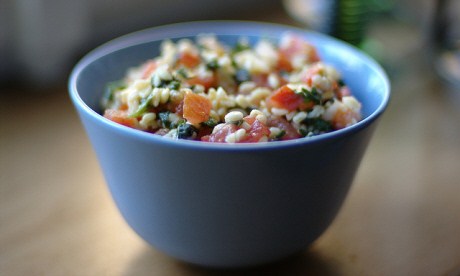
Jordanian food is all about getting your hands dirty – dig in to mounds of dips, breads and delectable dishes, recommends Matthew Teller
From sophisticated Lebanese styles to basic Bedouin fare, Jordanian cooking is a cosmopolitan mix of influences – and one of the great pleasures of travel in the Middle East.
Mediterranean-style mezze – a variety of appetisers, all served simultaneously for everyone to share – is king of cuisines in Jordan. Good restaurants might have 30 or 40 choices of mezze on the menu, ranging from simple dishes of herbs, olives, labneh (tart yoghurt) and hummus (chickpea dip) up to grander creations such as kibbeh (wheat and lamb torpedoes), tabbouleh (parsley and tomato salad), shanklish (spiced goat’s cheese) and warag aynab (stuffed vine leaves). Kibbeh nayeh (lamb’s meat pounded smooth and served raw) is a celebrated delicacy, while mini-mains such as lamb or chicken shish kebabs, mjeddrah (lentils with rice and onions) and mahshi (cooked vegetables stuffed with rice) are common. Also expect unlimited quantities of hot, fresh-baked khubez: flat bread, used for scooping and dipping.
Mezze exist to slow down the process of eating, turning a solitary refuelling into a convivial celebration of good food and good company. Two people might order four or five mezze; a party of eight could order 20. Sitting at a table swamped with colours and aromas, and sharing dishes of myriad flavours and textures, is a delight. Mezze can form an extended prelude to a series of main courses – generally carnivorous, comprising kebabs, grills or chicken – or they could be a full meal in themselves.
You’re likely to be eating with your fingers at least some of the time – generally using pieces of khubez to scoop up dips or to make one-bite sandwiches. Since the left hand is traditionally used for toilet purposes, Jordanians instinctively eat only with the right.
If you happen to be invited to a Bedouin celebration – such as a wedding in the desert – there’ll only be one dish on the menu: Jordan’s national speciality, the traditional Bedouin feast-dish of mansaf. This is a hearty affair comprising chunks of boiled lamb or mutton served on a bed of fatty rice, with pine nuts sprinkled on top and a tart, yoghurt-based sauce on the side. Elsewhere you may also find delicious Palestinian dishes, including musakhan – chicken steamed with onions and a sour-flavoured red berry called sumac.
The traditional Jordanian breakfast is a bowl of hot fuul (beans mashed with lemon juice, olive oil and chopped chillies), mopped up with fresh-baked khubez – guaranteed to keep you going for hours.
Larger hotels pride themselves on offering lavish breakfast buffets, encompassing hummus and dips, fresh fruit, fresh-baked bread, pancakes with syrup, an omelette chef on hand, and a variety of cooked options from hash browns, baked beans and fried mushrooms to ‘beef bacon’ (a substitute for real bacon which, being forbidden under Islam, is not available). Some even offer Japanese specialities such as miso soup and sushi.
Jordan’s staple street snack is falafel, small balls of a spiced chickpea paste deep-fried and served stuffed into khubez along with some salad, a blob of tahini (sesame-seed paste) and optional harr (hot sauce). Up and down the country you’ll also find shawarma – the local version of doner kebab, almost always lamb.
Coffee (qahwa) is a national institution – best taken Turkish style: thick, dark and sweet. Expect tea (shai) to come in small glasses, served strong, sweet, scalding hot and milkless.
The traditional way to round off a meal is with fresh fruit. For dessert, you’re generally best off heading to a local patisserie – of which there are dozens – for halawiyat (Arabic sweets). Plump for kunafa, a heavenly concoction of buttery shredded filo pastry layered over melted goat’s cheese, baqlawa (layered flaky pastry filled with pistachios), muhalabiyya (semi-set almond cream, flavoured with rosewater) or Umm Ali (local-style bread pudding, served hot, sprinkled with nuts and cinnamon).
As for timings, breakfasts are generally finished with by 8am (though big hotels serve until 10am or so), lunch is eaten between 1pm and 3pm, while the main meal of the day rarely starts before 8pm; some restaurants may not fill up until 10pm.
A pocket-guide to Jordanian wine
Drinking alcohol is forbidden under Islam. That said, Jordan is not Saudi Arabia, and locally brewed beers, spirits and surprisingly good wine are widely available.
Despite a gap of several centuries, Jordan’s history of winemaking – like that of its neighbours – reaches back into the biblical past. Today, thanks to the dedication of a few enthusiastic entrepreneurs, Jordan’s wine is starting to get noticed. The ‘Grands Vins de Jordanie’ brand, produced by businessman and wine enthusiast Omar Zumot, includes fruity cabernet and merlot (labelled St George) and fresh, very drinkable chardonnay/sauvignon blanc (labelled Machaerus). Another Jordanian firm, Haddad, trading as Eagle, is best known for its bright Mount Nebo whites, alongside the Jordan River range which includes a cabernet sauvignon, a rich, plummy shiraz and a light, spicy chardonnay. These – along with Palestinian wines tagged ‘Holy Land’ – are widely available in upmarket restaurants and duty-free shops alongside imported vintages.
Both Zumot and Eagle – as well as numerous Lebanese distilleries – also produce anise-flavoured arak (similar to Turkish raki), traditionally drunk over ice and diluted with water, to accompany a meal of mezze.